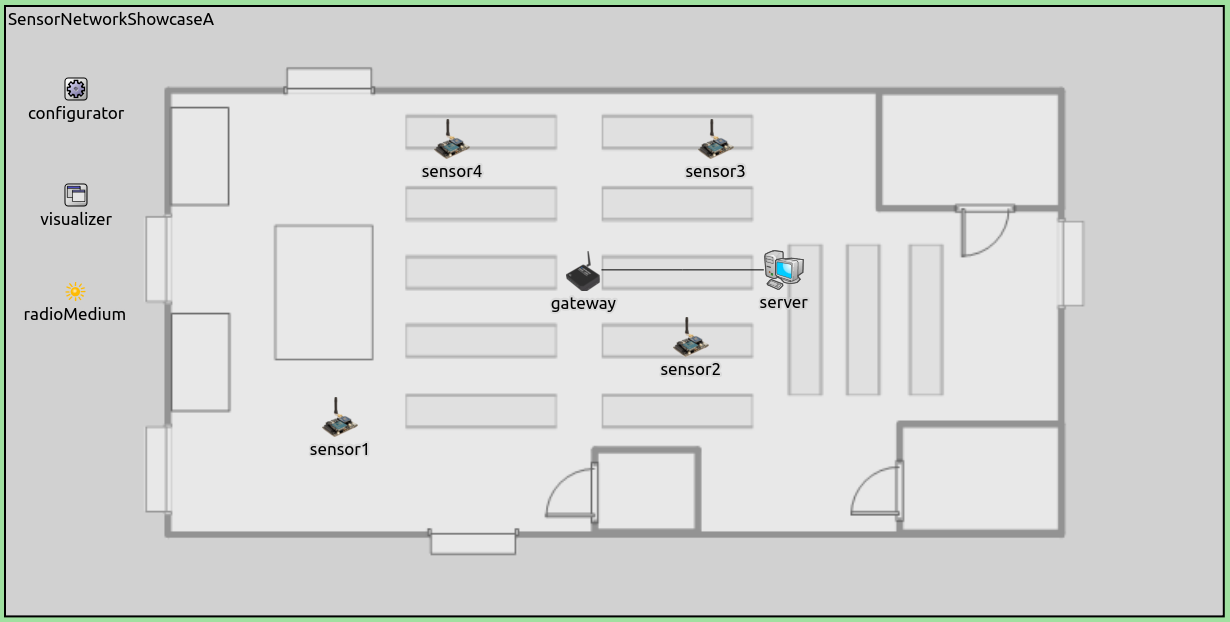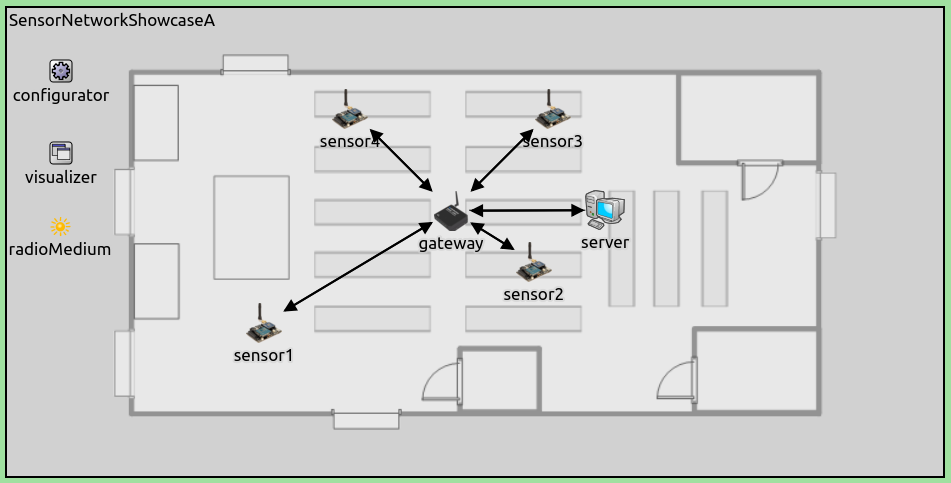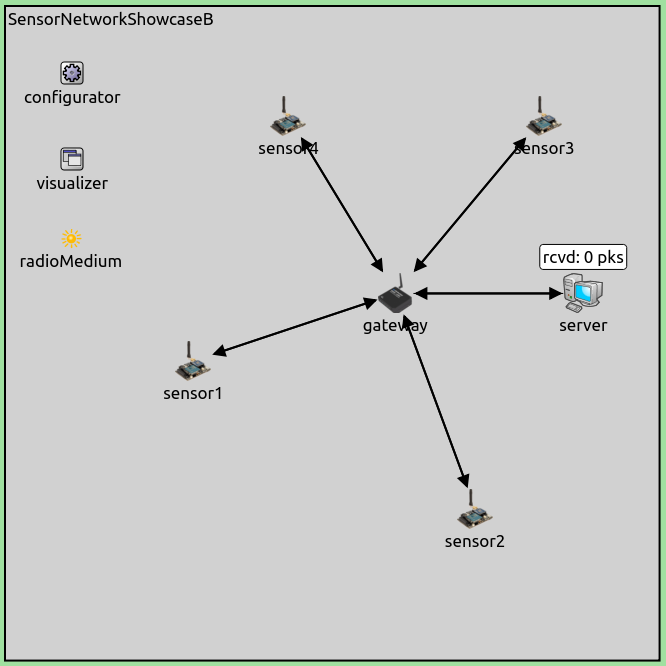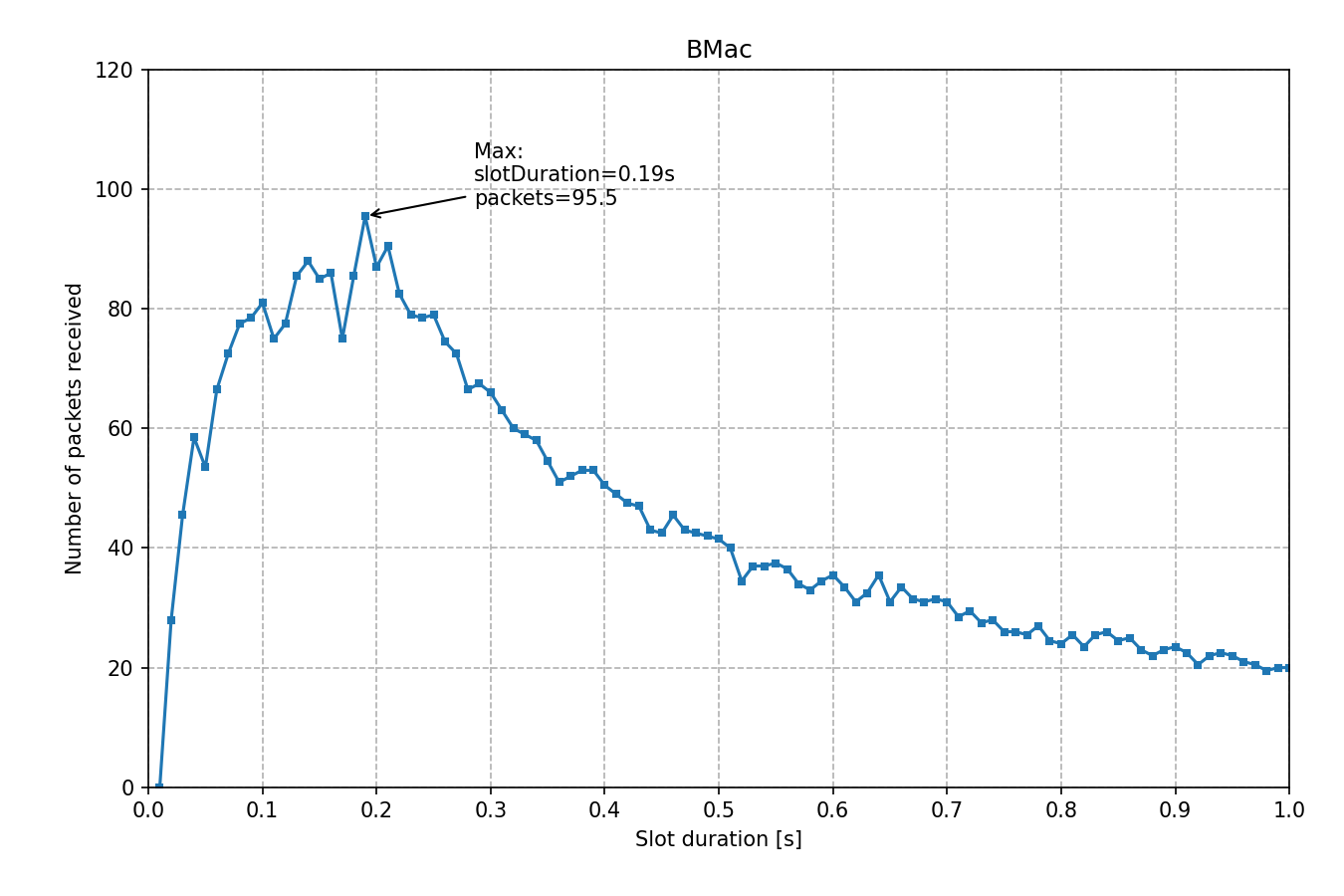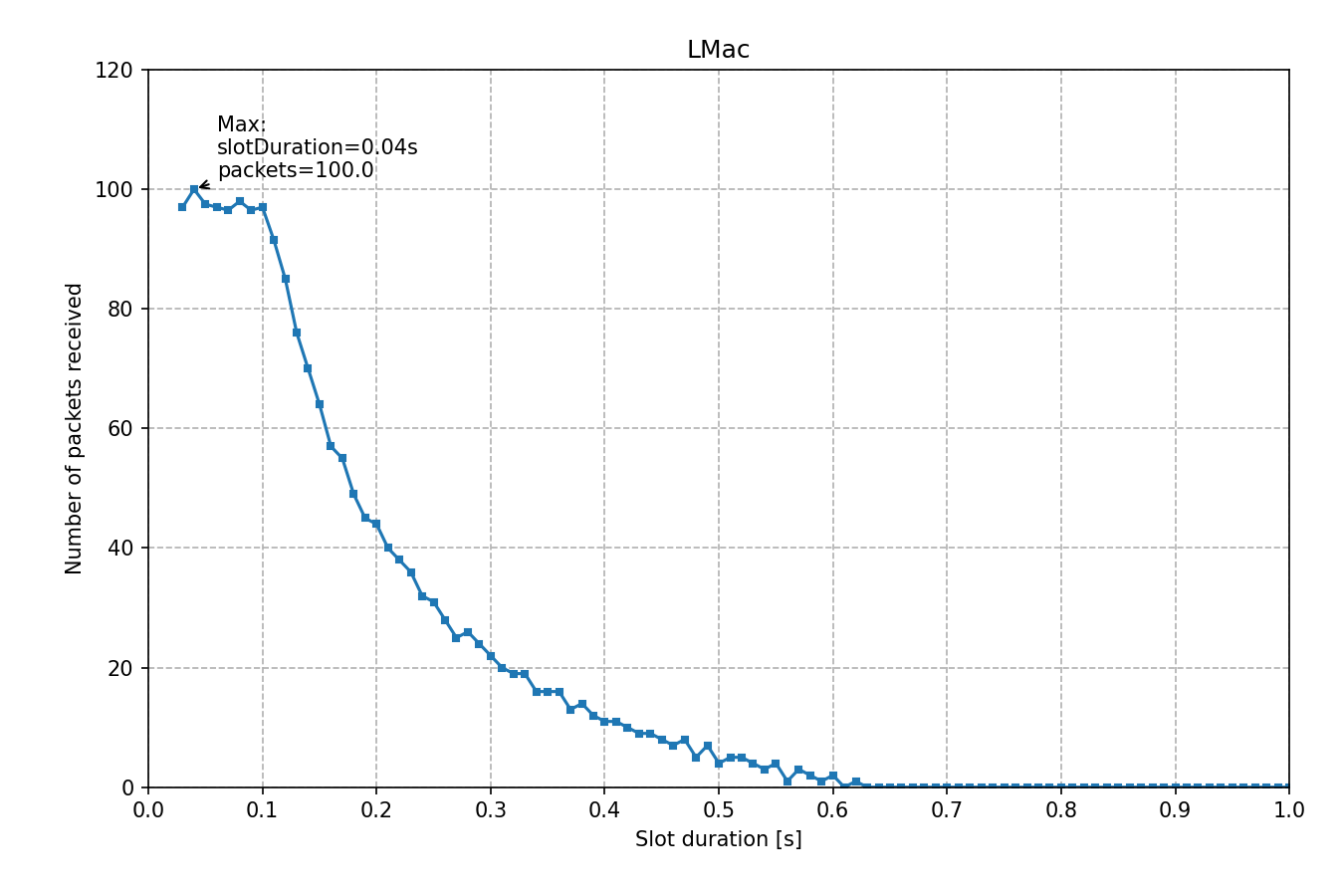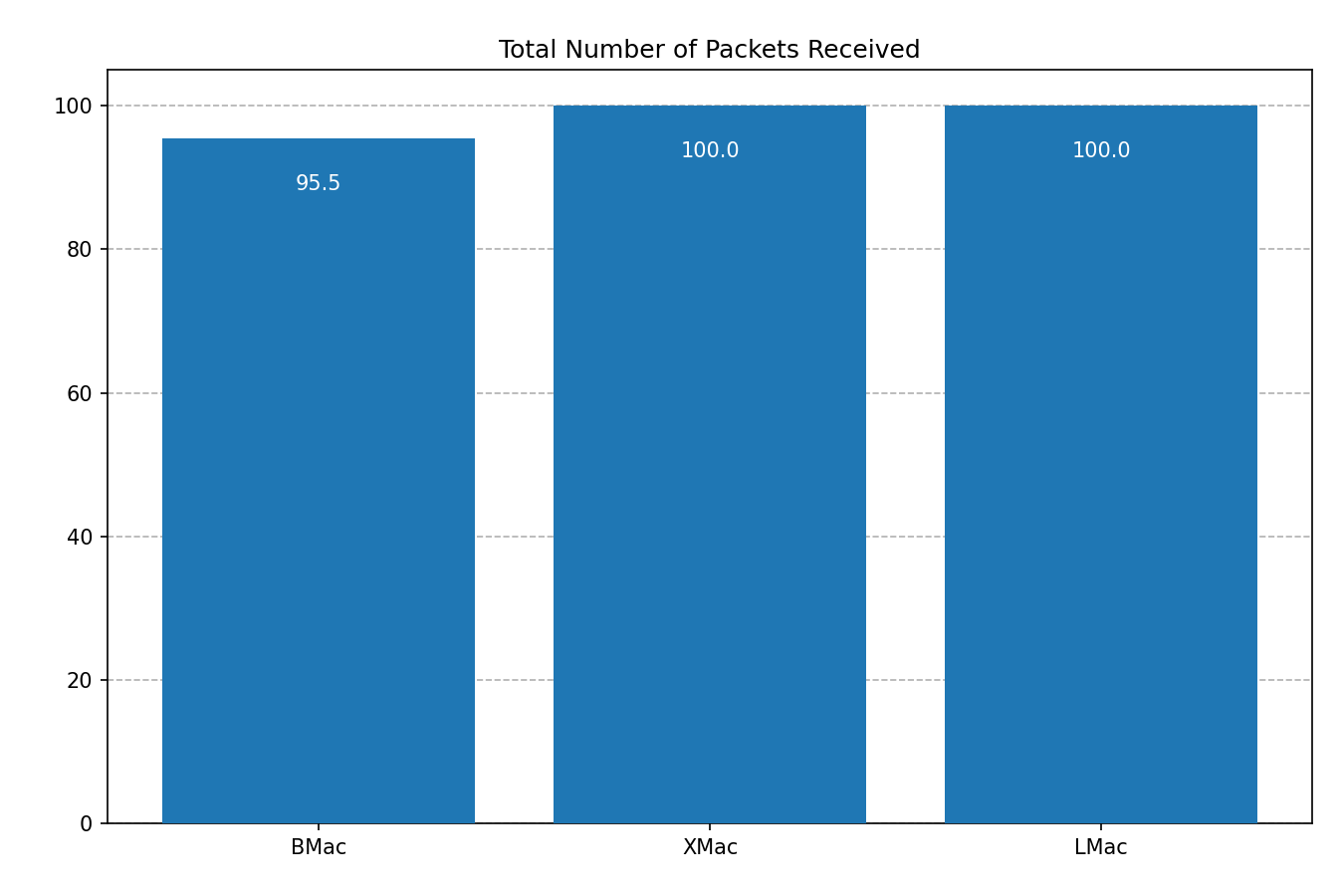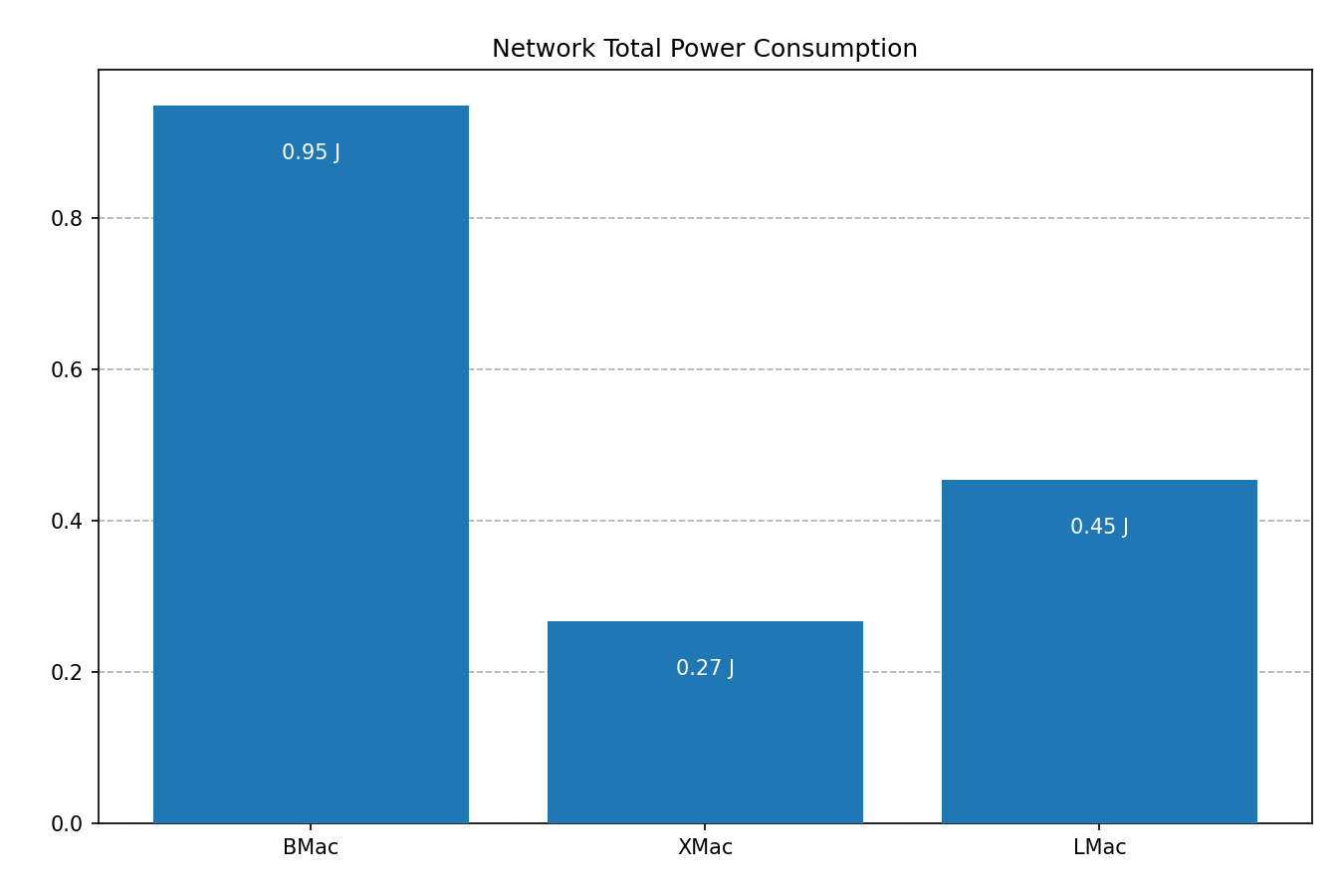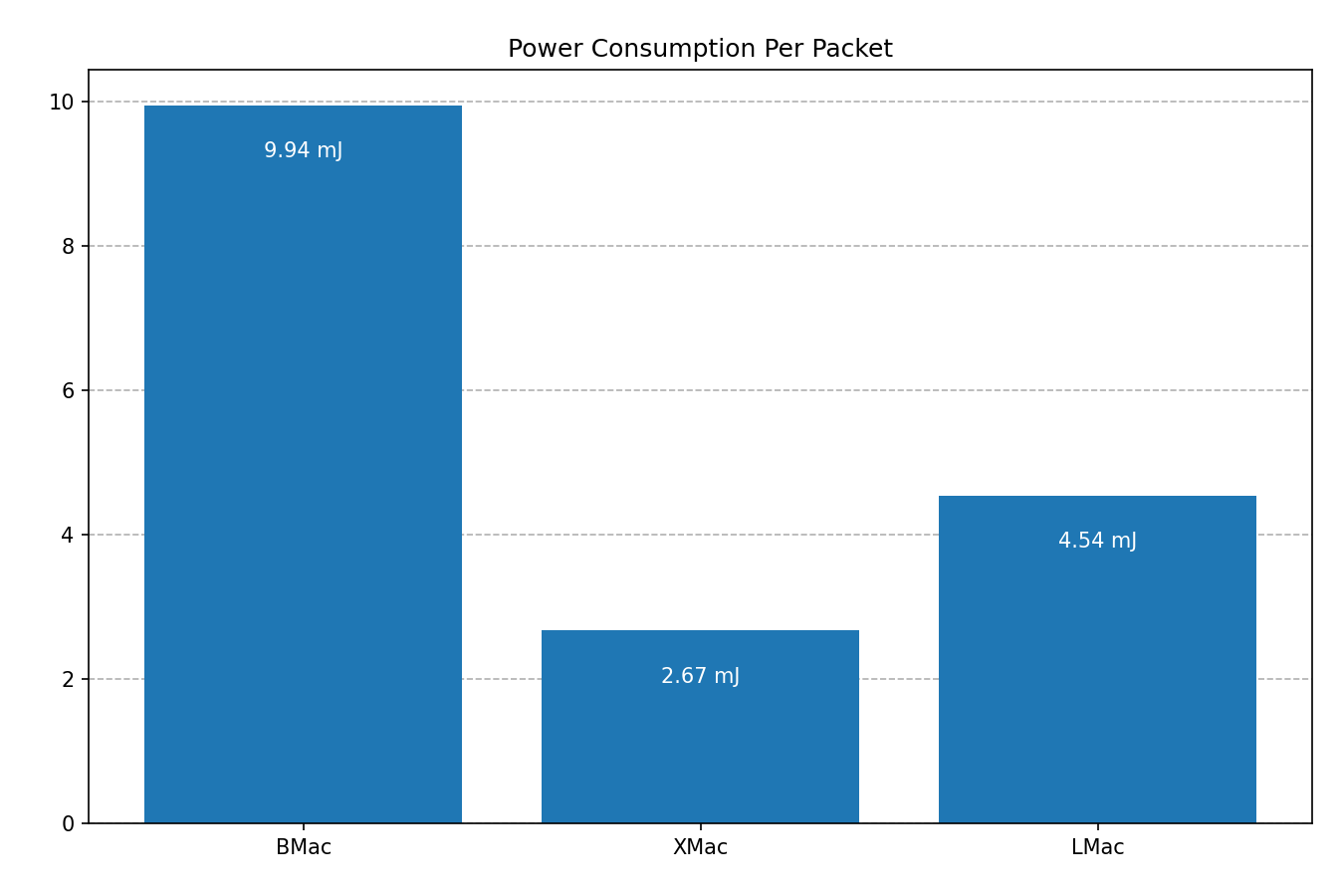MAC Protocols for Wireless Sensor Networks¶
Goals¶
INET has several MAC protocol implementations designed specifically for wireless sensor networks, in addition to IEEE 802.15.4 models. This showcase demonstrates three different such MAC protocols through example simulations. The showcase compares the performance of the three protocols using statistical analysis.
4.0Part 1: Demonstrating the MAC protocols¶
There are two main categories of MAC protocols for WSNs, according to how the MAC manages when certain nodes can communicate on the channel:
Time-division multiple access (TDMA) based: These protocols assign different time slots to nodes. Nodes can send messages only in their time slot, thus eliminating contention. Examples of this kind of MAC protocols include LMAC, TRAMA, etc.Carrier-sense multiple access (CSMA) based: These protocols use carrier sensing and backoffs to avoid collisions, similarly to IEEE 802.11. Examples include B-MAC, SMAC, TMAC, X-MAC.
This showcase demonstrates the WSN MAC protocols available in INET: B-MAC, LMAC, and X-MAC. The following sections detail these protocols briefly.
B-MAC¶
B-MAC (short for Berkeley MAC) is a widely used WSN MAC protocol; it is part of TinyOS. It employs low-power listening (LPL) to minimize power consumption due to idle listening. Nodes have a sleep period, after which they wake up and sense the medium for preambles (clear channel assessment - CCA.) If none is detected, the nodes go back to sleep. If there is a preamble, the nodes stay awake and receive the data packet after the preamble. If a node wants to send a message, it first sends a preamble for at least the sleep period in order for all nodes to detect it. After the preamble, it sends the data packet. There are optional acknowledgments as well. After the data packet (or data packet + ACK) exchange, the nodes go back to sleep. Note that the preamble doesn’t contain addressing information. Since the recipient’s address is contained in the data packet, all nodes receive the preamble and the data packet in the sender’s communication range (not just the intended recipient of the data packet.)
X-MAC¶
X-MAC is a development on B-MAC and aims to improve on some of B-MAC’s shortcomings. In B-MAC, the entire preamble is transmitted, regardless of whether the destination node awoke at the beginning of the preamble or the end. Furthermore, with B-MAC, all nodes receive both the preamble and the data packet. X-MAC employs a strobed preamble, i.e. sending the same length preamble as B-MAC, but as shorter bursts, with pauses in between. The pauses are long enough that the destination node can send an acknowledgment if it is already awake. When the sender receives the acknowledgment, it stops sending preambles and sends the data packet. This mechanism can save time because potentially, the sender doesn’t have to send the whole length preamble. Also, the preamble contains the address of the destination node. Nodes can wake up, receive the preamble, and go back to sleep if the packet is not addressed to them. These features improve B-MAC’s power efficiency by decreasing nodes’ time spent in idle listening.
LMAC¶
LMAC (short for lightweight MAC) is a TDMA-based MAC protocol. There are data transfer timeframes, which are divided into time slots. The number of time slots in a timeframe is configurable according to the number of nodes in the network. Each node has its own time slot, in which only that particular node can transmit. This feature saves power, as there are no collisions or retransmissions. A transmission consists of a control message and a data unit. The control message contains the destination of the data, the length of the data unit, and information about which time slots are occupied. All nodes wake up at the beginning of each time slot. If there is no transmission, the time slot is assumed to be empty (not owned by any nodes), and the nodes go back to sleep. If there is a transmission, after receiving the control message, nodes that are not the recipient go back to sleep. The recipient node and the sender node goes back to sleep after receiving/sending the transmission. Only one message can be sent in each time slot. In the first five timeframes, the network is set up and no data packets are sent. The network is set up by nodes claiming a time slot. They send a control message in the time slot they want to reserve. If there are no collisions, nodes note that the time slot is claimed. If there are multiple nodes trying to claim the same time slot, and there is a collision, they randomly choose another unclaimed time slot.
The INET implementations¶
The three MACs are implemented in INET as the BMac, XMac, and
LMac modules. They have parameters to adapt the MAC protocol to the
size of the network and the traffic intensity, such as slot time, clear
channel assessment duration, bitrate, etc. The parameters have default
values, thus the MAC modules can be used without setting any of their
parameters. Check the NED files of the MAC modules (BMac.ned,
XMac.ned, and LMac.ned) to see all parameters.
The MACs don’t have corresponding physical layer models. They can be used with existing generic radio models in INET, such as UnitDiskRadio or ApskRadio. We’re using ApskRadio in this showcase because it is more realistic than UnitDiskRadio.
INET doesn’t have WSN routing protocol models (such as Collection Tree Protocol), so we’re using Ipv4 and static routing.
Configuration¶
The showcase contains three example simulations, which demonstrate the three MACs in a wireless sensor network. The scenario is that there are wireless sensor nodes in a refrigerated warehouse, monitoring the temperature at their location. They periodically transmit temperature data wirelessly to a gateway node, which forwards the data to a server via a wired connection.
Note that in WSN terminology, the gateway would be called sink. Ideally,
there should be a specific application in the gateway node called
sink, which would receive the data from the WSN, and send it to the
server over IP. Thus the node would act as a gateway between the WSN and
the external IP network. In the example simulations, the gateway just
forwards the data packets over IP.
To run the example simulations, choose the BMac, LMac and
XMac configurations from omnetpp.ini.
Most of the configuration keys in the ini file are shared between the
three simulations (they are defined in the General configuration),
except for the MAC protocol-specific settings. All three simulations
will use the same network, SensorNetworkShowcaseA, defined in
SensorNetworkShowcase.ned:
In the network, the wireless sensor nodes are of the type
SensorNode, named sensor1 up to sensor4, and gateway.
The node named server is a StandardHost. The network also
contains an Ipv4NetworkConfigurator, an IntegratedVisualizer,
and an ApskScalarRadioMedium module. The nodes are placed against
the backdrop of a warehouse floorplan. The scene size is 60x30
meters. The warehouse is just a background image providing context.
Obstacle loss is not modeled, so the background image doesn’t affect
the simulation in any way.
The wireless interface in the sensor nodes and the gateway is specified
in omnetpp.ini to be the generic
WirelessInterface (instead of the Ieee802154 specific
Ieee802154NarrowbandInterface, which is the default wlan interface
in SensorNode). The radio type is set to ApskScalarRadio:
**.wlan[*].typename = "WirelessInterface"
**.wlan[*].radio.typename = "ApskScalarRadio"
Note that the wireless interface module’s name is wlan in all host
types that have a wireless interface. The term doesn’t imply that it’s
Wifi but stands for wireless LAN.
We are using ApskScalarRadio here because it is a relatively
simple, generic radio. It uses amplitude and phase-shift keying
modulations (e.g. BPSK, QAM-16 or QAM-64, BPSK by default), without
additional features such as forward error correction, interleaving or
spreading. We set the bitrate in
omnetpp.ini to 19200 bps, to match the
default for the MAC bitrates (we’ll use the default bitrate in the MACs,
which is 19200 bps for all three MAC types.) The preambleDuration is
set to be very short for better compatibility with the MACs. We also set
some other parameters of the radio to arbitrary values:
**.radio.centerFrequency = 2.45GHz
**.radio.bandwidth = 2.8MHz
**.radio.transmitter.bitrate = 19200 bps
**.radio.transmitter.headerLength = 8b
**.radio.transmitter.preambleDuration = 0.0001s
**.radio.transmitter.power = 2.24mW
**.radio.receiver.energyDetection = -90dBm
**.radio.receiver.sensitivity = -100dBm
**.radio.receiver.snirThreshold = -8dB
Routes are set up according to a star topology, with the gateway at the
center. This is achieved by dumping the full configuration of
Ipv4NetworkConfigurator (which was generated with the configurator’s
default settings), and then modifying it. The modified configuration is
in the config.xml file. The following
image shows the routes:
Each sensor node will send an UDP packet with a 10-byte payload
(“temperature data”) every second to the server, with a random start
time around 1s. The packets will have an 8-byte UDP header and a 20-byte
Ipv4 header, so they will be 38 bytes at the MAC level. The packets will
be routed via the gateway. Here are the application settings in
omnetpp.ini:
*.sensor*.numApps = 1
*.sensor*.app[0].typename = "UdpBasicApp"
*.sensor*.app[0].destAddresses = "server"
*.sensor*.app[0].destPort = 1000
*.sensor*.app[0].sendInterval = 1s
*.sensor*.app[0].startTime = exponential(1s)
*.sensor*.app[0].messageLength = 10Byte
*.server.numApps = 1
*.server.app[0].typename = "UdpSink"
*.server.app[0].localPort = 1000
The MAC-specific parameters are set in the configurations for the individual MACs.
For B-MAC, the wireless interface’s macType parameter is set to
BMac. Also, the slotDuration parameter is set to 0.025s (an
arbitrary value.) This parameter is essentially the nodes’ sleep
duration. Here is the configuration in
omnetpp.ini:
[Config BMac]
network = SensorNetworkShowcaseA
**.wlan[*].mac.typename = "BMac"
**.wlan[*].mac.headerLength = 1B
**.wlan[*].mac.slotDuration = 0.025s
For X-MAC, the wireless interface’s macType parameter is set to
XMac. The MAC’s slotDuration parameter determines the duration
of the nodes’ sleep periods. It is set to 0.25s for the sensor nodes
and 0.1s for the gateway. Nodes transmit preambles for the duration of
their own sleep periods unless interrupted by an acknowledgment from
the destination node. The design of X-MAC allows setting different sleep
intervals for different nodes, as long as the sender node’s sleep
interval is greater than the receiver’s. (?). We set the slot duration
of the gateway to a shorter value because it has to receive and relay
data from all sensors, thus it has more traffic. Here is the
configuration in omnetpp.ini:
[Config XMac]
network = SensorNetworkShowcaseA
**.wlan[*].mac.typename = "XMac"
**.wlan[*].mac.headerLength = 24B
*.gateway.wlan[*].mac.slotDuration = 0.1s
*.sensor*.wlan[*].mac.slotDuration = 0.25s
For LMAC, the wireless interface’s macType parameter is set to
LMac. The numSlots parameter is set to 8, as it is sufficient
(there are only five nodes in the wireless sensor network.) The
reservedMobileSlots parameter reserves some of the slots for mobile
nodes; these slots are not chosen by any of the nodes during network
setup. The parameter’s default value is 2, but it is set to 0. The
slotDuration parameter’s default value is 100ms, but we set it to
50ms to decrease the network setup time. The duration of a timeframe
will be 400ms (number of slots * slot duration.) The network is set up
in the first five frames, i.e. in the first 2 seconds. Here is the
configuration in omnetpp.ini:
[Config LMac]
network = SensorNetworkShowcaseA
**.wlan[*].mac.typename = "LMac"
**.mac.slotDuration = 50ms
**.mac.numSlots = 8
**.mac.reservedMobileSlots = 0
The next sections demonstrate the three simulations.
B-MAC¶
The following video shows sensor nodes sending data to the server:
BMac actually sends multiple shorter preambles instead of a long
one, so that waking nodes can receive the one that starts after they
woke up. sensor3 starts sending preambles, while the other nodes are
asleep. All of them wake up before the end of the preamble transmission.
When the nodes are awake, they receive the preamble, and receive the
data packet as well, at the physical layer (the mac discards it if it is
not for them.) Then the gateway sends it to the server. Note that all
nodes receive the preambles and the data packet as well.
X-MAC¶
In the following video, the sensors send data to the server:
sensor3 starts sending preambles. sensor4 wakes up and receives
one of the preambles (hence the dotted arrow representing a successful
physical layer transmission), and goes back to sleep, as the
transmission is addressed to the gateway. Then the gateway wakes up and
sends an acknowledgment after receiving one of the preambles.
sensor3 sends the data packet, and the gateway forwards it to the
server.
LMAC¶
In the following video, sensor nodes send data to the server:
Each node transmits in its own time slot; there are no collisions. Note that all nodes receive the control message (indicated by the physical link visualizer arrows), but only the destination node receives the data unit.
Part 2: Optimizing for packet loss and comparing power consumption¶
In this section, we’ll compare the three MAC protocols in terms of a few statistics, such as the number of UDP packets carried by the network, and power consumption. In order to compare the three protocols, we want to find the parameter values for each MAC, which lead to the best performance of the network in a particular scenario. We’ll optimize for the number of packets received by the server, i.e. we want to minimize packet loss.
The scenario will be the same as in the BMac, XMac and LMac configurations (each sensor sending data every second to the server), except that it will use a similar, but more generic network layout instead of the warehouse network:
We’ll run three parameter studies, one for each MAC protocol. We want to optimize just one parameter of each MAC, the slot duration. Ideally, one would want to optimize multiple parameters to find a more optimal set of parameter values, but it is out of scope for this showcase. The choices for the values of the other parameters are arbitrary.
We’ll choose the best performing parameters according to the number of packets received by the server.
The parameter study configurations for the three MAC protocols will
extend the StatisticBase config (as well as the General
configuration):
[Config StatisticBase]
network = SensorNetworkShowcaseB
#abstract-config = true (requires omnet 7)
**.vector-recording = false
repeat = 2
In this base configuration, we set the simulation time limit, the number of repetitions, and turn vector recording off to speed up the runs.
The parameter studies for the individual MACs are detailed in the following sections.
Optimizing B-MAC¶
The goal is to optimize BMac’s slotTime parameter for the number
of packets received by the server. The configuration in
omnetpp.ini for this is
StatisticBMac. Here is the configuration:
[Config StatisticBMac]
extends = StatisticBase
**.wlan[*].mac.typename = "BMac"
**.wlan[*].mac.headerLength = 1B
**.wlan[*].mac.slotDuration = ${slotDuration=0.01..1 step 0.01}s
In the study, slotDuration will run from 10ms to 1s in 10ms
increments (the default of slotDuration is 100ms.) The number of
packets received by the server for each slotDuration value is shown
on the following image (time in seconds):
The sensors send 25 packets each during the 25s, thus
100 packets total. It is apparent from the results that the network
cannot carry all traffic in this scenario. The results also outline a
smooth curve. The best performing value for
slotDuration is 0.19s.
Optimizing X-MAC¶
Again, we optimize the slotTime parameter for the number of packets
received by the server. As in the XMac configuration, the
slotTime for the gateway will be shorter than for the sensors. The
configuration in omnetpp.ini for this is
StatisticXMac. Here is the configuration:
[Config StatisticXMac]
extends = StatisticBase
**.wlan[*].mac.typename = "XMac"
#**.wlan[*].mac.headerLength = 24B
#**.wlan[*].mac.checkInterval = 25ms
*.gateway.wlan[*].mac.slotDuration = ${gwSlotDuration=0.01..1 step 0.01}s
The default of slotDuration for XMac is 100ms. In the study, the
gateway’s slotDuration will run from 10ms to 1s in 10ms increments,
similarly to the parameter study for B-MAC. The slotDuration for the
sensors will be 2.5 times that of the gateway (an arbitrary value.) Here
are the results (time in seconds):
According to this, the optimal value for the gateway’s slotDuration
is 0.04s (0.1s for the sensors).
Optimizing LMAC¶
We’ll optimize the slotDuration parameter for the number of packets
received by the server. The configuration for this study in
omnetpp.ini is StatisticLMac.
Here is the configuration:
[Config StatisticLMac]
extends = StatisticBase
#expected-result = "ERROR"
**.wlan[*].mac.typename = "LMac"
**.mac.slotDuration = ${slotDuration=0.01..1 step 0.01}s
**.mac.numSlots = 8
**.mac.reservedMobileSlots = 0
We set reservedMobileSlots to 0, and numSlots to 8. The
slotDuration parameter will run from 10ms to 1s in 10ms steps. The
number of received packets are displayed on the following image (time in
seconds):
It is apparent from the results that the network can carry almost all
the traffic in this scenario (as opposed to the XMac and LMac
results.) The best performing value for slotDuration is 40ms. Note
that the lowest slotDuration values up until 120ms yield
approximately the same results (around 100 packets), with the 40ms
value performing marginally better. Choosing the higher slotDuration
value would result in about the same performance but lower power
consumption, but we are optimizing for the number of packets here.
Measuring power consumption¶
We will examine the three simulations with the chosen parameters in terms of power consumption.
We want to record the power consumption of the radios in the wireless nodes. The SensorNode host type has an energy consumer submodule in its radio by default, SensorStateBasedEpEnergyConsumer. This module assigns a constant power consumption value to each radio mode and transmitter/receiver state. Note that the values for each state are parameters of the energy consumer module and don’t come from other modules (such as the radio), so they need to be set correctly to obtain accurate power consumption results. SensorStateBasedEpEnergyConsumer has default power consumption values typical for wireless sensor nodes, thus we leave module’s parameters on default. SensorNode has an energy storage submodule by default, IdealEpEnergyStorage. This module keeps track of the node’s energy consumption. It stores an infinite amount of energy, and cannot get fully charged or depleted, and it is useful if we only want to model and measure power consumption, but not energy capacity, charging, etc.
The results for the parameter studies contain the required power consumption data. We just need to select the result files corresponding to the best performing parameter values selected in the previous sections. We will plot the results on bar charts. We’ll examine the following statistics:
Total number of packets received: All the packets received by the server. The UDP applications in the sensors each send 25 packets during the 25s simulations, for a total of 100 packets. As there are 100 packets, this value is also the successful packet reception in percent, and indirectly, packet loss.Network total power consumption: The sum of the power consumption of the four sensors and the gateway (values in Joules.)Power consumption per packet: Network total power consumption / Total number of packets received, thus power consumption per packet in the entire network (values in Joules.)
Note that the values for the residualEnergyCapacity statistic are
negative, so it is inverted in the anf file. Here are the results:
From this, it is apparent that LMac and XMac carried all packets, and BMac had some packet loss. BMac consumed significantly more power than the others. BMac also has significantly more power consumption per packet. The conclusion is that in this scenario, with the selected parameter values, XMac turned out to be the most energy efficient MAC protocol.
extras.ini, ExtrasSensorNetworkShowcase.nedFurther information¶
Here are the documents describing the MAC protocols and the INET implementations:
Try It Yourself¶
If you already have INET and OMNeT++ installed, start the IDE by typing
omnetpp, import the INET project into the IDE, then navigate to the
inet/showcases/wireless/sensornetwork folder in the Project Explorer. There, you can view
and edit the showcase files, run simulations, and analyze results.
Otherwise, there is an easy way to install INET and OMNeT++ using opp_env, and run the simulation interactively.
Ensure that opp_env is installed on your system, then execute:
$ opp_env run inet-4.0 --init -w inet-workspace --install --chdir \
-c 'cd inet-4.0.*/showcases/wireless/sensornetwork && inet'
This command creates an inet-workspace directory, installs the appropriate
versions of INET and OMNeT++ within it, and launches the inet command in the
showcase directory for interactive simulation.
Alternatively, for a more hands-on experience, you can first set up the workspace and then open an interactive shell:
$ opp_env install --init -w inet-workspace inet-4.0
$ cd inet-workspace
$ opp_env shell
Inside the shell, start the IDE by typing omnetpp, import the INET project,
then start exploring.
